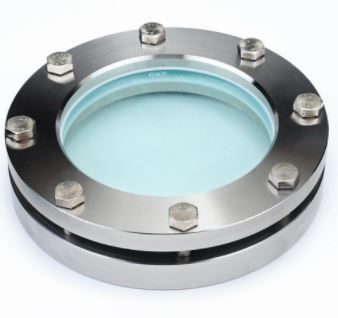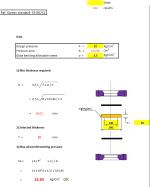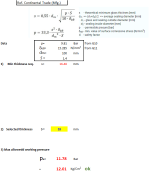Sight Glass Thickness Calculation

Description
The program calculates sight glass thickness, according the pressure and glass dimensions. Program is using Korean's Standard and Manufecturer's (Continental) standard.
Sight glass thickness calculation is an important aspect of ensuring the safety and performance of a sight glass used in industrial equipment. The thickness of a sight glass depends on factors such as the pressure and temperature of the fluid it will contain, the type of fluid, the size of the sight glass, and relevant industry standards.
Here is a general procedure to calculate the required sight glass thickness:
-
Determine the design conditions:
- Operating pressure (P) and temperature (T) of the fluid
- Sight glass diameter (D) or dimensions
- Type of fluid (corrosive, abrasive, etc.)
-
Identify the appropriate material for the sight glass:
- Material properties, such as the modulus of elasticity (E) and Poisson's ratio (ν)
- Material's allowable stress (σ_allowable)
-
Choose an appropriate design standard or code, such as ASME BPVC Section VIII (for pressure vessels), or the manufacturer's recommendations for the sight glass.
-
Use an appropriate formula or method to calculate the minimum required thickness (t) for the sight glass based on the design conditions, material properties, and applicable design code. For example, for a simple, circular sight glass without reinforcement, you can use the following formula based on the ASME BPVC Section VIII, Division 1 formula for a flat plate:
t = (P * D) / (2 * σ_allowable * F + P)
Where:
- F is a design factor, typically 1 for full-face gaskets, but it could vary based on the specific application and code requirements
Note that this is a simplified formula, and actual calculations can be more complex, depending on the design code, sight glass geometry, and other factors.
-
Check the calculated thickness against any additional requirements, such as minimum thickness requirements from the manufacturer or industry standards.
-
Apply a corrosion allowance and/or any other additional allowances, if necessary, to determine the final required thickness.
-
Select a commercially available sight glass thickness that meets or exceeds the calculated thickness.
It's important to consult a qualified engineer and follow the appropriate design standards or codes when determining the required sight glass thickness for your specific application.
Calculation Preview
Full download access to any calculation is available to users with a paid or awarded subscription (XLC Pro).
Subscriptions are free to contributors to the site, alternatively they can be purchased.
Click here for information on subscriptions.



